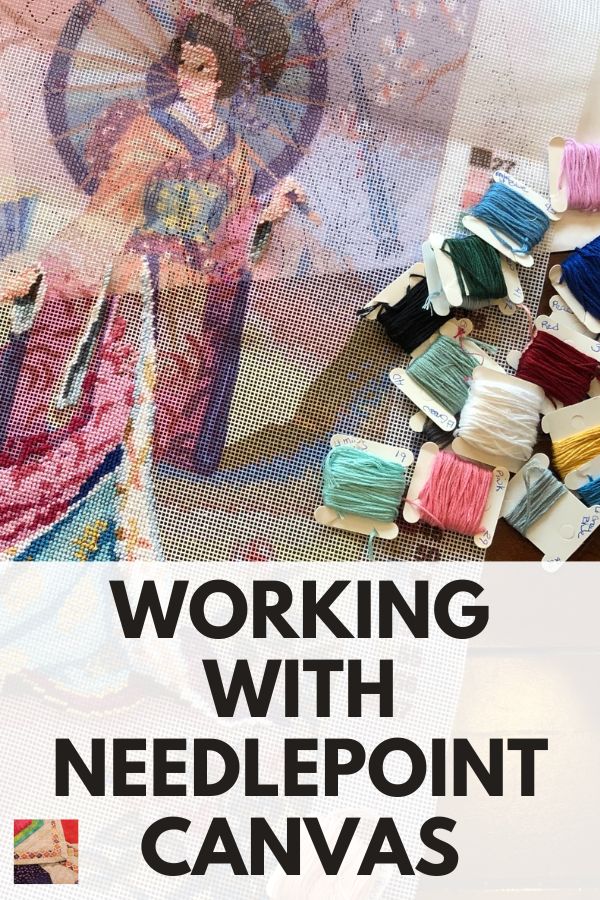Have you given much thought to needlepoint canvases?
This page provides all of the information that is needed to understand needlepoint canvases. Different types of canvases are explained, as well as tapestry canvases and even ways to repair canvases.
It is sometimes surprising to stitchers to learn how much the needlepoint canvas choice affects the finished needlepoint project. Each of the different canvases have attributes that make it the best canvas for certain projects.
What are the types of needlepoint canvas?
The four basic types of needlepoint canvases are Penelope, Mono, Interlock, and Plastic.
Penelope canvas is also called Double mesh or Duo canvas. It is a strong canvas that will work best for items which will experience much use and wear and tear. It is woven with double threads in both directions that can be pulled apart for making small details.
Mono canvas, also known as Uni-mesh, Uni-canvas or Uni, is the perfect canvas to use if making upholstery. Bargello needlepoint works well on this particular canvas, and it’s a good canvas for those who have done needlepoint before.
Mono canvas has some “give” in it which makes it a good choice for cushions and chair covers. However, if the design has areas of half cross stitch, this canvas will distort and not keep its shape.
Interlock canvas is the best choice for beginners to needlepoint. This canvas is made with two threads twisted together in both directions, preventing fraying and distortion.
Plastic canvas is very versatile. It is strong and stiff, making it perfect for needlepointing 3D projects. Since it is molded and not woven, the canvas can be cut without fraying. Kids learning to needlepoint do well with this canvas.
Take a look at the free plastic canvas projects page to try this out!
How do you keep needlepoint canvases from fraying?
Except for plastic canvas, other needlepoint canvases will eventually fray when cut. There are several ways to prevent this common problem.
- Sewn on Bias Tape: Because the fabric bias tape is very soft, it is important to sew it on to keep it in place. Use bias tape that is at least ½” wide for best coverage.
- Hemming Tape: Hemming tapes, with their sticky backing, keep needlepoint canvases from fraying and they are very thin. The backing adhesive is strong enough to keep the tape in place.
- Artist Tape: This acid-free tape is very strong and sturdy, but has a tendency to fall off if the project is not worked on a frame. The advantage to this tape is that it won’t damage the canvas if left on for a long period.
- Masking Tape: I have always used masking tape, and before the other types of tape were made available, most people used this to keep the canvas from fraying. It does leave a yellow residue on the canvas if left on long enough, but usually that portion of the needlepoint canvas is cut off.
Scroll down this page to learn more about needlepoint canvas and its importance in project usage. How to repair canvas, choose gauge, mend torn canvas, and washing instructions are just a few of the topics to be explored!

Supporting Products and links: Some of the links below may be affiliate links.
We make a small commission on sales through the affiliate links, at no extra cost to you. Thank you in advance
for your purchase and your support! Please see our full Affiliate
Statement for more information.
|
Visit Amazon to purchase brand name needlepoint canvas.
Affiliate Link to Amazon
|
|
|
How to select the correct needlepoint canvas for the needlepoint project.
Needlepoint
|
|
|
Needlepoint canvases come in different sizes or gauges. Some have imperfections. Read this article to learn about buying needlepoint canvas.
Needlepoint Teacher
|
|
|
In this blog post, find the definitions of the various canvases available on the market and when to use them.
Needlepoint Teacher
|
|
|
|
|
What to do if the canvas is accidentally cut or torn? Check out the blog post.
Needlepoint Teacher
|
|
|
Which needlepoint canvas should you use? Learn about the different types of needlepoint canvas.
Needlepoint For Fun
|
|
|
There are three main types of needlepoint canvas. Learn about them.
Serendipity Needleworks
|
|
|
This is the ultimate guide to everything needlepoint canvas.
The Spruce Crafts
|
|
|
|
|
Learn about the different types of needlepoint canvases.
Needlework Tips and Techniques
|
|
|
This post explains how to stitch on Penelope needlepoint canvas.
Needlepoint For Fun
|
|
|
Stitching needlepoint rugs and large wall hangings may require joining canvases together. Learn how here.
Needlepoint Teacher
|
|
|
We sometimes face this question “How do I repair a hole in my unstitched needlepoint canvas?” There are two ways to fix the problem. Learn more here.
Nuts About Needlepoint
|
|
|
|
|
You have a rip or tear in the needlepoint canvas. What can you do? Here is a simple solution.
Needlepoint For Fun
|
|
|
The different types of tapestry/needlepoint canvas available on the market are Mono, Interlock, Penelope/Duo, Rug and Plastic Canvas. Learn more about them.
DMC
|
|
|
You have many options to use when transferring your motif on canvas. Some are very poor choices and others are great. Let's take a look at the options.
Needlepoint Teacher
|
|
|
What is waste canvas? This product creates a stitching grid and is made to be removed after stitching. Here is a blog post on how to use waste canvas when needlepointing.
Needlepoint Teacher
|
|
|
Which needlepoint canvas should you use?
Needlepoint For Fun
|
|
|
Which Needlepoint Canvas is best for your project? This blog post will try to help you.
Needlework Tips and Techniques
|
|